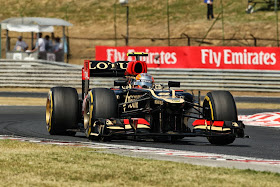It seems appropriate for us to end this round of Further Thoughts... with Sebastian Vettel. We know by now that he isn't everyone's cup of tea, but surely even those with the iciest views of young Seb will have had them thawed at least a little by the sight of him cutting loose after taking the flag last Sunday and with it his latest championship crown. As has been replayed seemingly without end since, rather than return to parc ferme as is the standard tepid way he instead indulged in doughnuts on the pit straight in front of the packed and roaring grandstand, then bowed in front of the car in worship, before climbing the spectator fence and - redolent of Nigel Mansell - throwing his gloves into the crowd. It was a fantastic and, apparently, spontaneous display of emotion from Vettel, him showing simple child-like joy and desire for everyone to share the moment with him. Everyone loved it.
 |
| Surely not even the most vociferous Seb-baiter will not have appreciated his Indian post race celebrations Photo: Octane Photography |
The stewards simply were applying the rules as they are, and as they've been applied in the past, so ill-will towards them is harsh. I'm also always rather loath to seek to resolve such situations by calling for 'common sense' to be applied, as I don't think such a call is especially helpful, given someone's interpretation of common sense is - despite its title - usually subjective, ill-defined as well as its usage often results in gross inconsistency of rules' application, which would also be bound to get people's backs up. And in almost every such case of F1 stewards enforcing an apparently bad rule one finds after a little investigation that, in spite of initial appearances, the rule actually exists for a good reason.

























